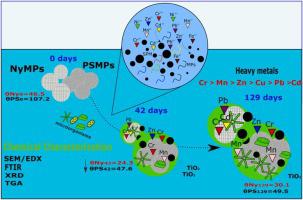Journal of Hazardous Materials ( IF 12.2 ) Pub Date : 2022-08-12 , DOI: 10.1016/j.jhazmat.2022.129737 A D Forero-López 1 , L I Brugnoni 2 , B Abasto 3 , G N Rimondino 4 , V L Lassalle 5 , M G Ardusso 1 , M S Nazzarro 6 , A M Martinez 7 , C V Spetter 3 , F Biancalana 1 , Fernández-Severini 1

|
In this study, the influence of the plastisphere on metals accumulation and weathering processes of polystyrene (PSMPs) and nylon microplastics (NyMPs) in polluted waters during a 129 day-assay were studied. MPs were characterized through scanning electron microscopy (SEM) with Energy dispersive X-ray (EDX), X-ray diffraction (XRD), attenuated total reflectance Fourier transformed infrared (ATR-FTIR) spectroscopy, contact angle, and thermogravimetric analysis (TGA). Also Cr, Mn, Zn, Cd, Pb, and Cu in the plastisphere on MPs were analyzed during the assay. Potentially pathogenic Vibrio, Escherichia coli, and Pseudomonas spp. were abundant in both MPs. Ascomycota fungi (Phona s.l., Alternaria sp., Penicillium sp., and Cladosporium sp.), and yeast, were also identified. NyMPs and PSMPs exhibited a decrease in the contact angle and increased their weights. SEM/EDX showed weathering signs, like surface cracks and pits, and leaching TiO2 pigments from NyMPs after 42 days. XRD displayed a notorious decrease in NyMPs crystallinity, which could alter its interaction with external contaminants. Heavy metal accumulation on the plastisphere formed on each type of MPs increased over the exposure time. After 129 days of immersion, metals concentrations in the plastisphere on MPs were in the following order Cr ˃ Mn ˃ Zn ˃ Cu ˃ Pb ˃ Cd, demonstrating how the biofilm facilitates metal mobilization. The results of this study lead to a better understanding of the impact of marine plastic debris as vectors of pathogens and heavy metals in coastal environments.
中文翻译:

塑料微球上的塑料球:河口环境中的原位测定
在这项研究中,在 129 天的测定中,研究了塑料球对污染水域中聚苯乙烯 (PSMPs) 和尼龙微塑料 (NyMPs) 金属积累和风化过程的影响。MPs 通过扫描电子显微镜 (SEM) 与能量色散 X 射线 (EDX)、X 射线衍射 (XRD)、衰减全反射傅里叶变换红外 (ATR-FTIR) 光谱、接触角和热重分析 (TGA) 进行表征. 在测定过程中,还分析了 MPs 上塑料球中的 Cr、Mn、Zn、Cd、Pb 和 Cu。潜在致病性弧菌、大肠杆菌和假单胞菌属。两位国会议员都很丰富。子囊菌门真菌 ( Phona sl, Alternaria sp.,还鉴定了青霉属、枝孢菌属和酵母菌。NyMPs 和 PSMPs 表现出接触角的减小和重量的增加。SEM/EDX 显示出风化迹象,如表面裂纹和凹坑,以及 TiO 2浸出42 天后来自 NyMP 的色素。XRD 显示出众所周知的 NyMPs 结晶度下降,这可能会改变其与外部污染物的相互作用。随着暴露时间的延长,每种 MPs 上形成的塑料球上的重金属积累增加。浸泡 129 天后,MPs 塑料球中的金属浓度依次为 Cr ˃ Mn ˃ Zn ˃ Cu ˃ Pb ˃ Cd,表明生物膜如何促进金属迁移。这项研究的结果有助于更好地了解海洋塑料碎片作为病原体和重金属载体在沿海环境中的影响。











































 京公网安备 11010802027423号
京公网安备 11010802027423号